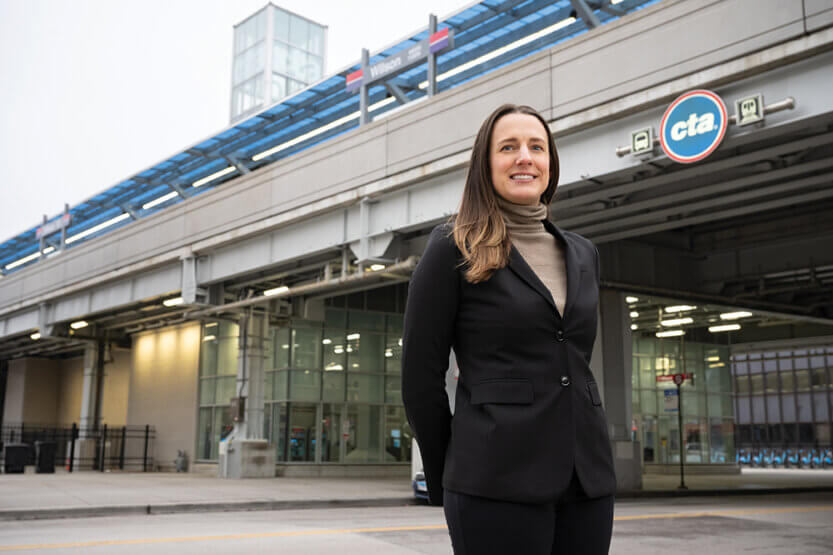Alumni Interview: Mary Lou Kutska
 Standing before her first engineering project, the Wilson Red Line station in Chicago, Kutska says, “It’s cool to see something go from an analytical model on your computer screen to a real-life version.” In 2022, she received the
Outstanding Young Engineer Award from the Structural Engineers Association of Illinois. (Image by Mary Rafferty)
Standing before her first engineering project, the Wilson Red Line station in Chicago, Kutska says, “It’s cool to see something go from an analytical model on your computer screen to a real-life version.” In 2022, she received the
Outstanding Young Engineer Award from the Structural Engineers Association of Illinois. (Image by Mary Rafferty) I’d been at my job as a bridge technical manager at the engineering firm Michael Baker International for two months when I got a photo message from my supervisor. It was a picture of a large crack in a tied-arch bridge over the Mississippi River. I said to myself, “This can’t be good.”
That was my whirlwind introduction to the Hernando de Soto bridge emergency repair—easily the most rewarding project of my young career.
In May 2021, our firm was inspecting the cable elements of the bridge, which connects Memphis, Tenn., and West Memphis, Ark. The inspection team peered over the edge and discovered the crack. They knew that if it were to fail, the results would be catastrophic.
Inspectors leaped into action, closing the bridge to vehicle traffic. Meanwhile, back in the office, everyone at the firm mobilized.
My role was to create a 3D model of the structure—a duplicate of the primary model our engineers were building in Louisville, Ky. We aimed to validate their results as quickly as possible. That way, we could ensure we weren’t over-stressing any other bridge element as we made repairs.
The bridge was re-opened to traffic just 83 days after the crack’s discovery. It took long hours and a village of effort—a trial-by-fire experience. But it was amazing to see the direct impact my work could have on the public’s safety.
I’ve always been a problem-solver. I trace this back to my parents, who both worked for the Federal Reserve Bank of Chicago. During long road trips when I was growing up, they would teach me simple math problems. Those progressed into more complex puzzles.
Now, when I have a problem placed in front of me, I treat it like a puzzle. Solving it brings me a true sense of accomplishment.
In high school, my advanced physics teacher recommended me for a women’s day program at Argonne National Laboratories. I took a tour and had lunch with a female engineer. She asked me about my interests. I told her I liked design and architecture, but worried I wouldn’t have enough advanced math and science.
“I was more attracted to the idea of building something people use every day—something that would benefit everyone.” —Mary Lou Kutska, ’11 ENG
She told me to consider structural engineering, which has elements of design and math. I took her advice, and that’s how I started down this path.
I began my studies at Cornell University. While it was great to get away from home and meet new people, it wasn’t for me. I missed the Midwest, and there was a great school right here close to home. So, I transferred to U of I, where my parents had gone.
The opportunities I found there were massive. I traveled around the world to study and attend conferences—Madrid, China, Brazil. On campus, I loved classes like Design of Structural Systems. Professors provided architectural plans for a building and we designed all the elements, including beams and columns. It was a real-world application of what I would be doing in the future.
I completed several internships as an undergrad and in my master’s program at the University of California, Berkeley. One covered stadium design. But I was more attracted to the idea of building something people use every day—something that would benefit everyone.
That’s what led me to bridges. My first job, at the engineering firm HNTB, was as a bridge engineer. The first project I worked on was the Wilson Red Line station in Chicago.
When the project was completed, I took a station tour. It’s cool to see something go from an analytical model on your computer screen to a real-life version. You can watch people walk and bike on your structure, using what you’ve created.
I’ll admit, it’s not always easy being a woman in this field. Several years ago, I went to Springfield for an Illinois Dept. of Transportation subcommittee meeting on bridges. I was early, so I sat down and watched people walk in. By the end of the meeting, there was one other woman in a room of over 50 people.
It was a bit overwhelming, but I tried to take it in stride and separate emotion from facts. I’m there to do my job, and I’m going to walk into the room and do my job, no matter who else is there.
Since my undergraduate days, I’ve stayed active in organizations like the Society of Women Engineers. There, I can connect with other women about our shared experiences.
I also mentor girls through ACE, a program focusing on architecture, construction and engineering. Recently, I ran into a former mentee at a volunteer event. I’d worked with her when she was in high school. Now, she’s a curriculum leader at the Chicago Architecture Center, helping teach girls about STEM.
The experience made me reflect on how important it is to help others through doors that have opened for you. You’re not just helping one person through that door. You’re also setting the stage for that person to turn around and do the same thing.

